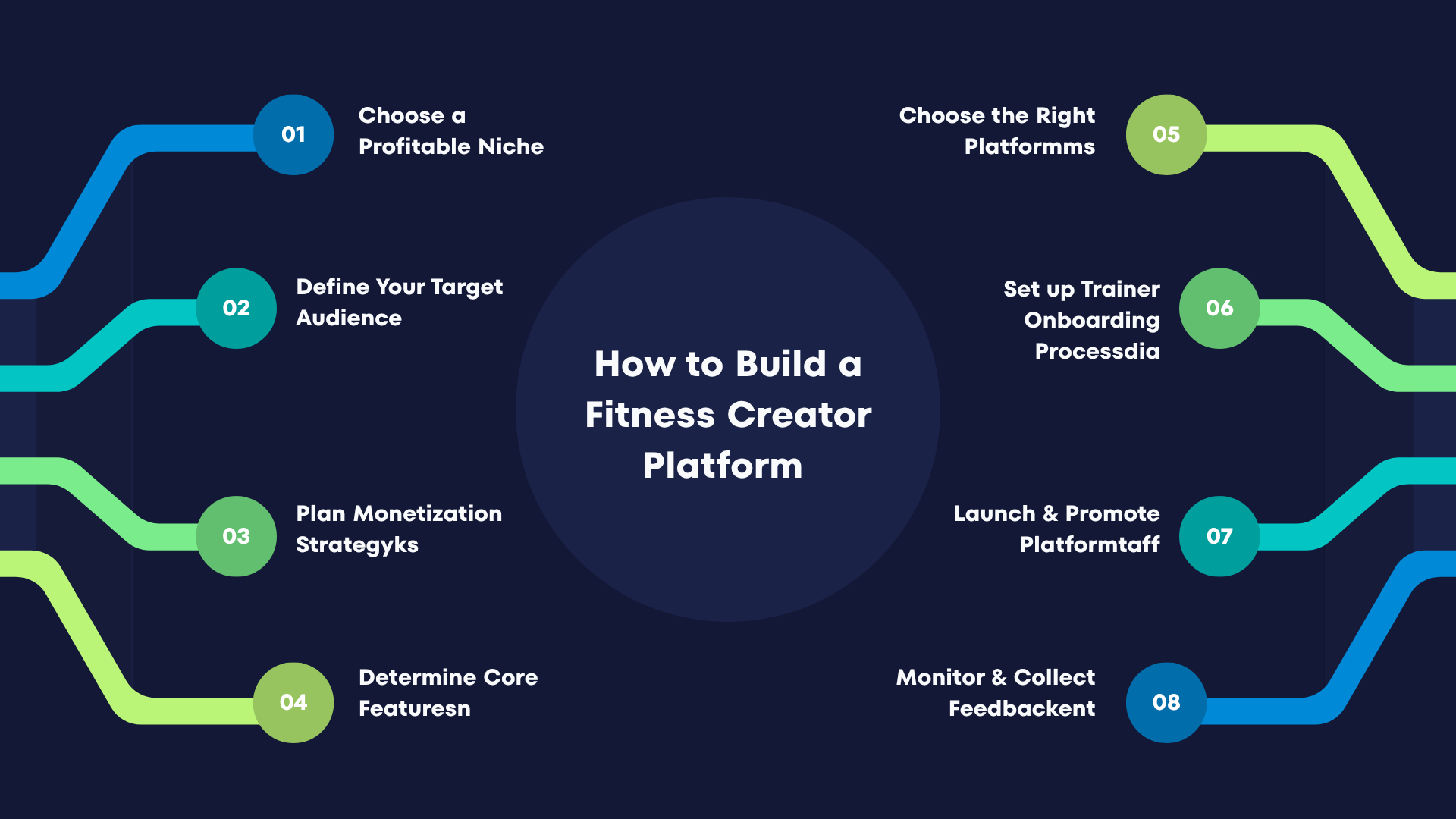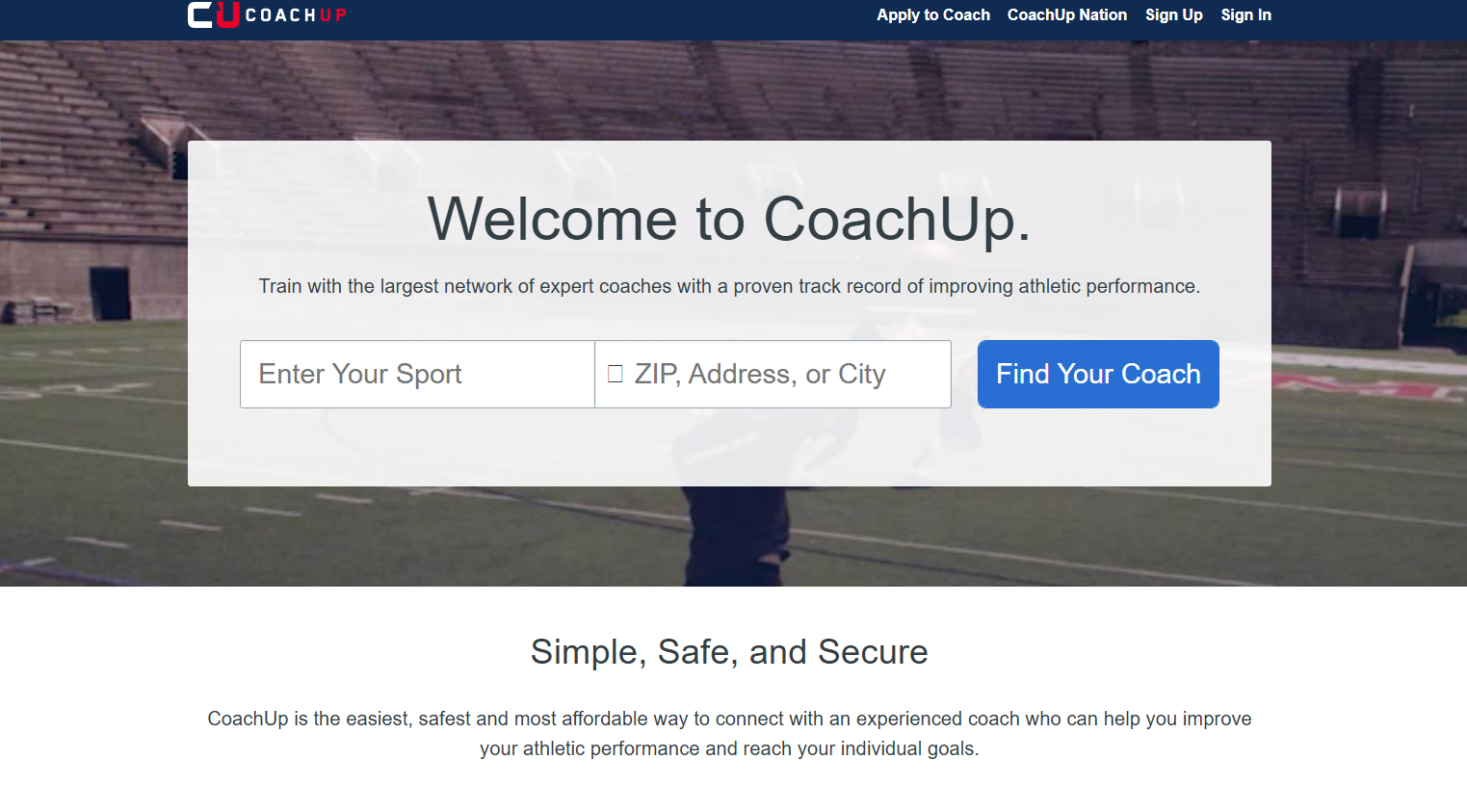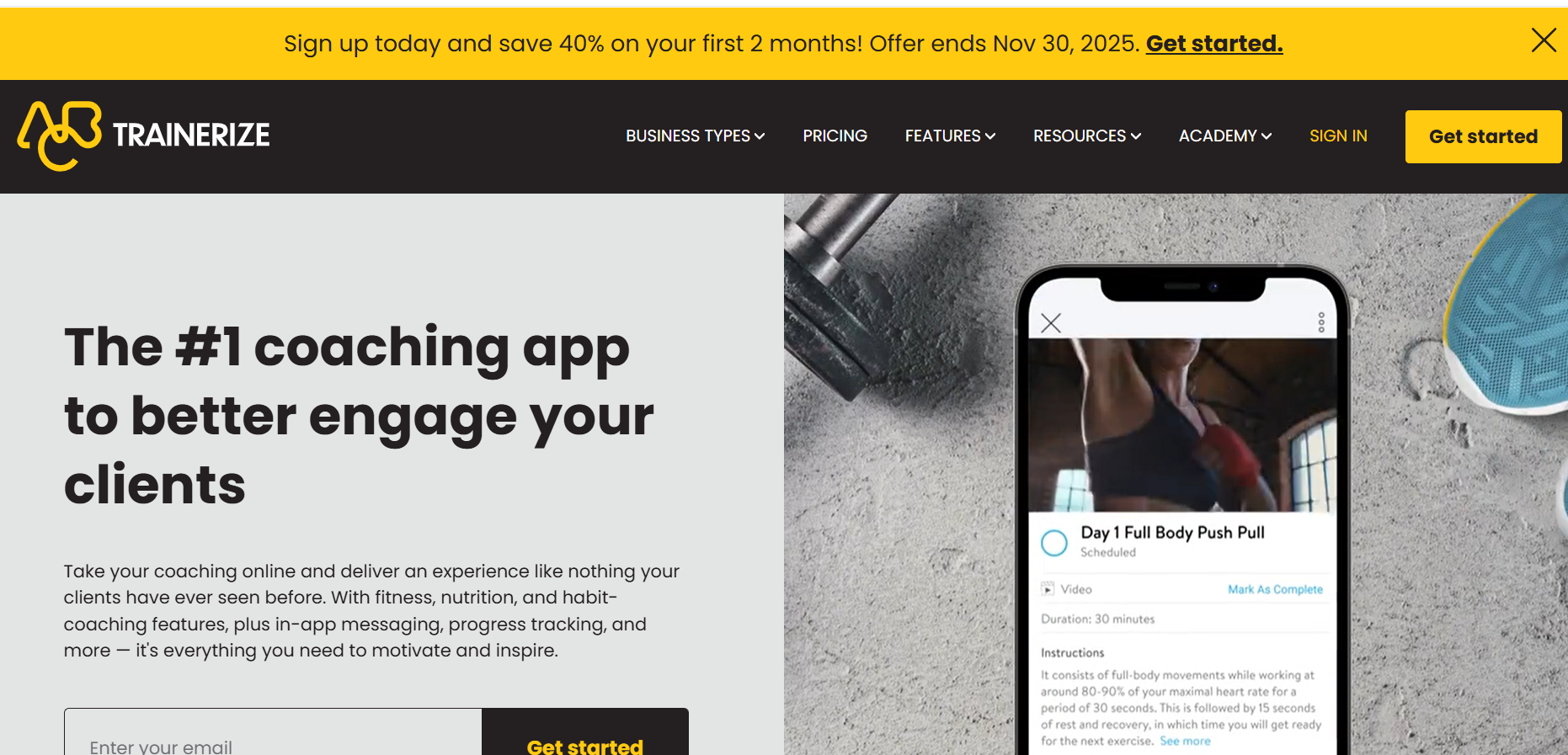Planning to launch your fitness creator platform and build your own empire? Well, you don’t need to abandon your long-cherished dream due to a lack of technical or coding skills.
What if we tell you that you can build your platform with zero coding skills?
From handling content management and monetization to community engagement and personalization, we’ll cover everything needed to build your fitness platform. But first, let’s understand how a fitness creator platform works and about its core audience!
Table of Contents
- 1 Understanding Fitness Creator Platforms: How They Work, Benefits, and Who Needs Them?
- 2 Features of Fitness Creator Platform
- 3 How to Build a Fitness Creator Platform That Connects Trainers: 8 Easy Steps
- 4 How Much Does it Cost to Build a Fitness Creator Platform?
- 5 Examples of Popular Fitness Creator Platforms
- 6 Conclusion
- 7 FAQ-Related to How to Build a Fitness Creator Platform That Connects Trainers
Understanding Fitness Creator Platforms: How They Work, Benefits, and Who Needs Them?
A fitness creator platform is a digital platform where fitness instructors or personal trainers can sell their training programs, live classes, memberships, and manage communities. These are more of an all-in-one platform that connects trainers to members.
Creators can monetize their fitness expertise from different revenue streams, including subscriptions, one-time classes, workout plans, premium coaching, guides and sponsorships.
How Do They Work?
A fitness creator platform works similar to a marketplace, where trainers connect with members. The platform has three main entities: admin, creators and members or users.
Trainers can create and sell fitness programs or workout videos in any niche of their choice. They can create and upload on-demand video lessons and host live classes on the platform. Further, they can also package them as subscriptions or sell them as one-time classes. Creators can decide the pricing limits for monthly subscriptions.
Now, let’s understand how the platform works from a member’s perspective! Fitness enthusiasts can set goals and personalize the platform based on their preferences. Once they subscribe to their favourite trainers, they can access the workout programs, live classes and get post updates on to their feeds.
Lastly, they can track their progress, activities, and even join communities to achieve their fitness goals.
Why Start Fitness Creator Platform?
- Growing demand for fitness & health content
- Recurring revenue
- Diverse revenue streams, such as subscriptions, one-time classes, merchandise, memberships
- Building domain authority and credibility
- Scalable business model
Who Needs Them?
- Personal trainers
- Established influencers building communities
- Fitness experts
- Health & wellness experts
- Sports or athletic trainers
- Users/ Fitness enthusiasts
Features of Fitness Creator Platform
Below are the key features for fitness creator platform:
1. User Features
- Login/Registration
Create a simple and seamless login process with username, email id and social login.
- Creator Discovery & Filtering
Whether your platform hosts ten or hundreds of creators, finding them should not be a chore! An intuitive search tool with filters, such as fitness category, content style, price, makes it easier. You could even include featured listings or recommendations based on user’s preferences.
- Booking & Scheduling
A user-friendly interface to manage live class bookings, schedule and payments makes scheduling easier.
- Live Classes
Allow users to access live workouts, interactive Q&A, and AMA sessions. This pulls in engagement and fosters creator-member relationships!
- Subscriptions & Premium Training Programs
Include fitness subscriptions packed with on-demand training videos, live classes, workout plans, progress tools, etc.
- Communication & Platform Reminders
Chats, session reminders, messages creates seamless communication workflows.
- Payment Integrations
Secure payment integrations with Stripe and PayPal help users to purchase subscriptions and one-time classes.
- Goal Setting & Progress Tracking
This feature helps users to set fitness goals and visualize their progress. Design interactive dashboards to track activity, record statistics and capture their fitness journey.
- Engagement & Community
User engagement & community features retain users for long-term. Forums, gamification elements(badges, rewards,streaks), fitness challenges, post updates, likes, comments, drive engagement.
2. Trainer Features
- Profile Setup
Building a strong profile is crucial for trainers. Bio, profile image, banner allows creators to personalize and build a solid brand.
- Upload or Stream Classes
This feature allows trainers to upload and manage on-demand videos and host live classes. Drip content and PPVs (locked content) keeps ongoing engagement for subscription-style content. Provide an easy-to-use interface with drag-and-drop program builder, workout library, video integration for designing workout programs.
- Trainer Dashboard & Analytics
A comprehensive trainer dashboard helps to track user’s progress, earnings, and engagement over time.
- Subscription & Monetization
Trainers can create subscription tiers, decide pricing, and even receive tips or donations. Include revenue analytics & payouts section, so trainers can keep track of their revenue.
3. Admin Features
- User/Member Management
Admin can add, modify, and manage member profiles. Managing user roles and permissions ensures platform’s privacy & security
- Trainer Management
Admin can also add, manage, verify and approve trainer profiles. Admin also has the right to suspend or reject specific trainer profiles for discrepancies.
- Payment & Revenue Management
A robust admin dashboard can track platform payments, commissions, manage payment methods, and approve payouts.
- Content Moderation & Approval
Admin approves and manages platform content, such as workout videos, PDFs, and other resources. On top of that, they can also manage categories, filters and tags.
- Branding & Platform Settings
Branding is a powerful tool to stand out from the competitors. White-labeled clone scripts like Fanso.io allow strong branding features, including banners, logos, email templates, and platform customization. So, you can say goodbye to forced branding and reinforce your own brand identity!
How to Build a Fitness Creator Platform That Connects Trainers: 8 Easy Steps
Here’s a step-by-step guide for building your fitness creator platform:
- Choose a Profitable Niche
- Define Your Target Audience
- Plan Monetization Strategies
- Determine Core Features
- Choose the Right Platform
- Set up Trainer Onboarding Process
- Launch & Promote Platform
- Monitor & Collect Feedback

Step # 1: Choose a Profitable Niche
Your fitness creator platform begins with a solid niche. This helps to tap into high demand, specific audiences, and underserved markets.
The main purpose of your fitness platform is to lead members towards transformation & wellness. For trainers, the platform is a stage to offer training programs, sell courses and memberships and monetize from the same. For users, it offers guidance to attain their fitness goals.
So, everything depends on laying a strong foundation – the right niche!
Few profitable niches include:
- General Fitness & Strength – Weight Loss, Body-Building, HIIT
- Sub-Niches targeting specific audiences – Senior fitness, Postpartum Fitness, corporate wellness programs
- Sports Fitness Training – Endurance sports, combat sports, team sports
- Holistic Wellness & Recovery Programs – Yoga, Meditation, Mindfulness, Pilates
How to Find the Right Niche for Your Fitness Creator Platform?
- Discover the trending niches (Cross-functional training, HIIT, body-building)
- Research the top 2-3 competitors (Fitclass, Trainerize, ABC Fitness platform): niches, revenue models, marketing, etc
- Use Google Trends, Semrush, TikTok, Instagram, and Reddit to identify opportunities
- Validate the profitability and monetization potential of the niche
Step # 2: Define Your Target Audience
Next, research your ideal target audience. This helps to understand their needs and preferences and design a platform that helps them attain fitness goals.
A fitness creator platform has two types of audience: trainers and clients.
-
Trainers or Creators
Create training programs, courses, memberships, and monetize from their expertise. Trainers prioritize intuitive design, easy booking and payments, competitive pay, and engagement features.
-
Clients
Clients enroll with the training programs and follow instructions to attain their fitness goals. They prioritize features, such as quality training experts, an easy trainer discovery tool, and secure and convenient payments.
Create detailed buyer personas on their age, fitness goals, pain points, income, education, profession, interests, etc. Also, conduct surveys and user interviews.
Ask questions like:
- What is your age group? What are your favourite activities for fitness workouts?
- Are there any immediate fitness goals?
- Do you want to have daily or weekly bookings?
- What are the challenges and motivations to achieve goals?
Step # 3: Plan Monetization Strategy
The key to a successful fitness creator platform is finding the right revenue streams. You’ll need to figure out monetization based on your niche and audience.
Some popular revenue streams for fitness platforms include:
- 1-on-1 or small group classes where users pay for individual classes or workout programs
- Subscriptions with access to live classes, nutrition plans, training videos and tools
- Commissions from training sessions and programs
- Corporate Wellness Programs with companies
- Courses & memberships, including access to communities and forums
- Sponsorships or partnerships with fitness brands, gyms, and apparel
- Equipment & merchandise like branded gears, apparel, accessories
Step # 4: Determine Core Features – Live Classes, Bookings, Payments
The next step is to plan the core features and an interactive UX for your platform.
The key features of your fitness creator platform are:
- Login/Registration
- Easy Creator Discovery & Filters
- Booking & scheduling classes
- Live Classes
- Subscriptions & bundles
- Payment integrations and payouts
- Communication – chats, notifications, reminders
- Analytics & insights
- Community & engagement
- Admin Dashboard
Ensure your platform is user-centric, scalable, and mobile-friendly. Know what your customers want.
Thoughtfully organize your platform into different sections: training programs, live classes, courses & memberships. Simple fonts, stunning visuals, and workout images make the platform visually appealing!
Step # 5: Choose the Right Platform
There are three ways for developing your fitness creator platform: Ready-made clone scripts, no-code builders, and building it from scratch yourself.
Let’s understand each of them briefly!
|
Approach |
Best For | Pros |
Cons |
|
Ready-made Fitness creator clone scripts like Fanso.io |
Entrepreneurs with who want to launch platform quickly with minimal technical skills (even suitable for high-customization and branding needs) |
|
|
|
No-code builders (Bubble, Webflow) |
Entrepreneurs who want don’t want to take traditional coding approach |
|
|
|
Building from scratch |
Entrepreneurs who have technical expertise and an in-house development team |
|
|
To conclude, ready-made clone scripts are a great option with a powerful feature set, quick launch, strong customization and scalability needs. Above all, you get complete ownership and control, without any technical expertise and all at an affordable cost!
Step # 6: Set up Trainer Onboarding Process
A seamless onboarding for trainers ensures a great platform experience from the start! From defining trainer eligibility criteria to profile setup and ongoing training, setting up a seamless onboarding process needs work!
Adopt these practical onboarding strategies:
- Define your selection criteria — certifications, teaching experience, niche and qualifications
- Advertise on social media and communities about your recruitment
- Evaluate the candidates based on eligibility and establish a fair selection process
- Aim for a frictionless onboarding from profile setup to platform training
- Provide ongoing engagement & robust training environment — workshops, webinars, analytics, etc.
Establishing the right training process is all about attracting, retaining and empowering trainers.
Step # 7: Launch & Promote Your Fitness Platform
Long story short, you have a solid business model, a robust development approach, and professional trainers.
So, you have ticked all the boxes of the development plan. Finally, it’s time to hit the ground running!
Once the final testing is done, launch your platform and announce it on all your key channels. Collect feedback on interface, feature set, and navigation from your group of users
Well, you can’t sit back and enjoy your platform’s success. Just give it a thought — how would the audience know about your platform? For that, you need to spread the word!
Here are marketing strategies to broaden reach:
- Maximize social media presence on Instagram, TikTok, and YouTube reels
- Offer referral bonus and incentives for new user sign-ups
- Build community with forums, fitness challenges, live classes and more
- Get interviewed on a fitness podcast
- Start a YouTube channel
Step # 8: Monitor & Collect Feedback
Monitor your platform’s performance over time to sustain long-term success.
Track these key KPIs:
- Monthly and Annual Revenue
- Active users
- Engagement rate
- Trainer & user retention
- User experience
- Session bookings
Analyze user behaviour and patterns that make users keep coming back. Monitoring is not just about new signups; you need to collect feedback, adapt, and evolve!
For example, if a user reports issues with a feature, promptly fix the technical glitch. Roll out new features as per user requests and business needs.
How Much Does it Cost to Build a Fitness Creator Platform?
The cost to build a fitness creator platform is $30,000 and $100,000 when building from scratch. The overall development cost depends on the feature complexity, hourly development costs, integrations, and location.
Here’s a detailed cost breakdown:
|
Fitness App Type |
Features |
Development Cost ($30 per hour) |
|
Basic Platform |
|
$30,000 – $40,000 |
|
Medium Platform |
Basic features +
|
$40,000 – $60,000 |
|
Complex Platform |
Medium-level features +
|
$60,000 – $100,000+ |
*(Building a fitness creator platform from scratch takes around 6 to 12 months.)
Examples of Popular Fitness Creator Platforms
Need some extra inspiration to build your creator platform? Let’s look at a few successful fitness platforms generating revenue from their businesses.
1. CoachUp
CoachUp is a US-based online marketplace founded in 2011. It connects fitness coaches with athletes for over 60 sports, from soccer to basketball. It offers both one-on-one and group coaching.
The popular sports coaching platform monetizes from commissions, one-time activation charges and annual membership fees from coaches. The main goal of the platform is to connect trainers with athletes with a smart discovery and matching system.
USP: Large network of trusted and verified coaches, easy booking and scheduling

2. ABC Trainerize
ABC Trainerize is not purely a marketplace-style fitness platform, but more of a personal training software for trainers to grow their business. The software allows personal instructors and fitness coaches to design training programs and sell it directly to clients.
Along with helping trainers with personalized fitness business, Trainerize also caters to small and medium businesses, such as gyms and personal training studios. On-demand fitness training program delivery, scheduling, habit tracking, meal planning, and payment integrations are its core platform features.
USP: All-in-one fitness training platform, custom-branding, high engagement

Conclusion
Building a fitness creator platform is a profitable business, considering the booming industry. But, you need to pick the right niche, monetization streams, and empowering features to make it a big hit!
If you already have a million-dollar idea and plan, we at Fanso.io can help you transform your vision into reality! Embracing a ready-made fitness creator platform clone script like Fanso.io helps you to save time and effort and launch your platform within weeks!
Contact us and scale your fitness business with our cutting-edge technology. So, are you ready to revolutionize the fitness industry?
FAQ-Related to How to Build a Fitness Creator Platform That Connects Trainers
1. Is it profitable to build a fitness creator platform?
Yes, it is profitable to build a fitness creator platform given its growing demand. The global health and fitness club is estimated to reach $202.78 billion by 2030. Entrepreneurs, gyms, personal trainers, and influencers can earn significant revenue from fitness creator platforms.
2. How can I monetize from fitness creator platforms?
These are the key revenue streams for fitness creator platforms:
- 1-on-1 sessions or small group classes
- Subscriptions
- Courses & memberships
- Premium 1-on-1 training sessions
- Corporate wellness programs & partnerships
- Sponsorships & Ads
- Affiliate Programs
3. Who can build fitness creator platforms?
Entrepreneurs, gyms, established fitness trainers, and influencers can typically scale their businesses with a fitness creator platform.


